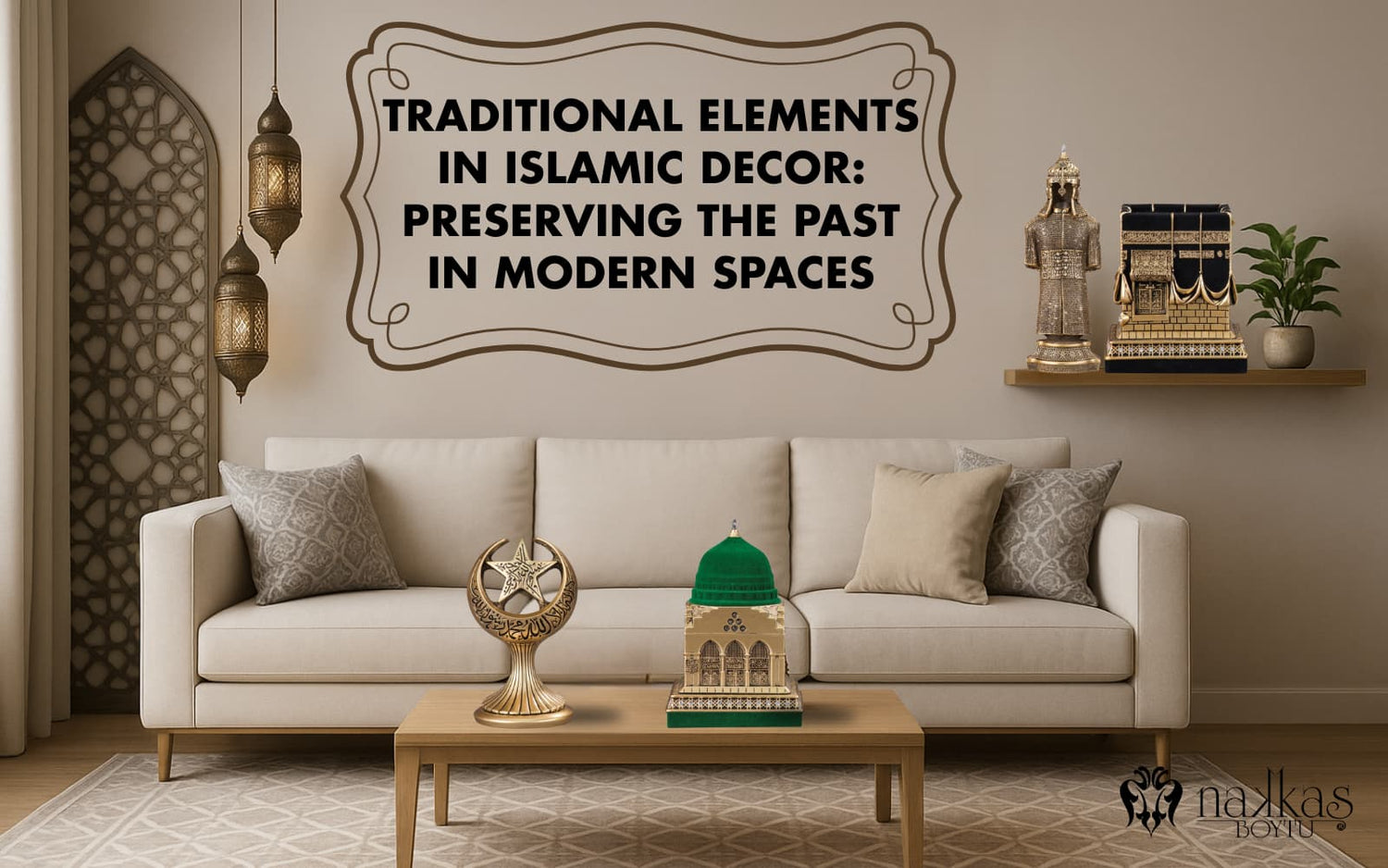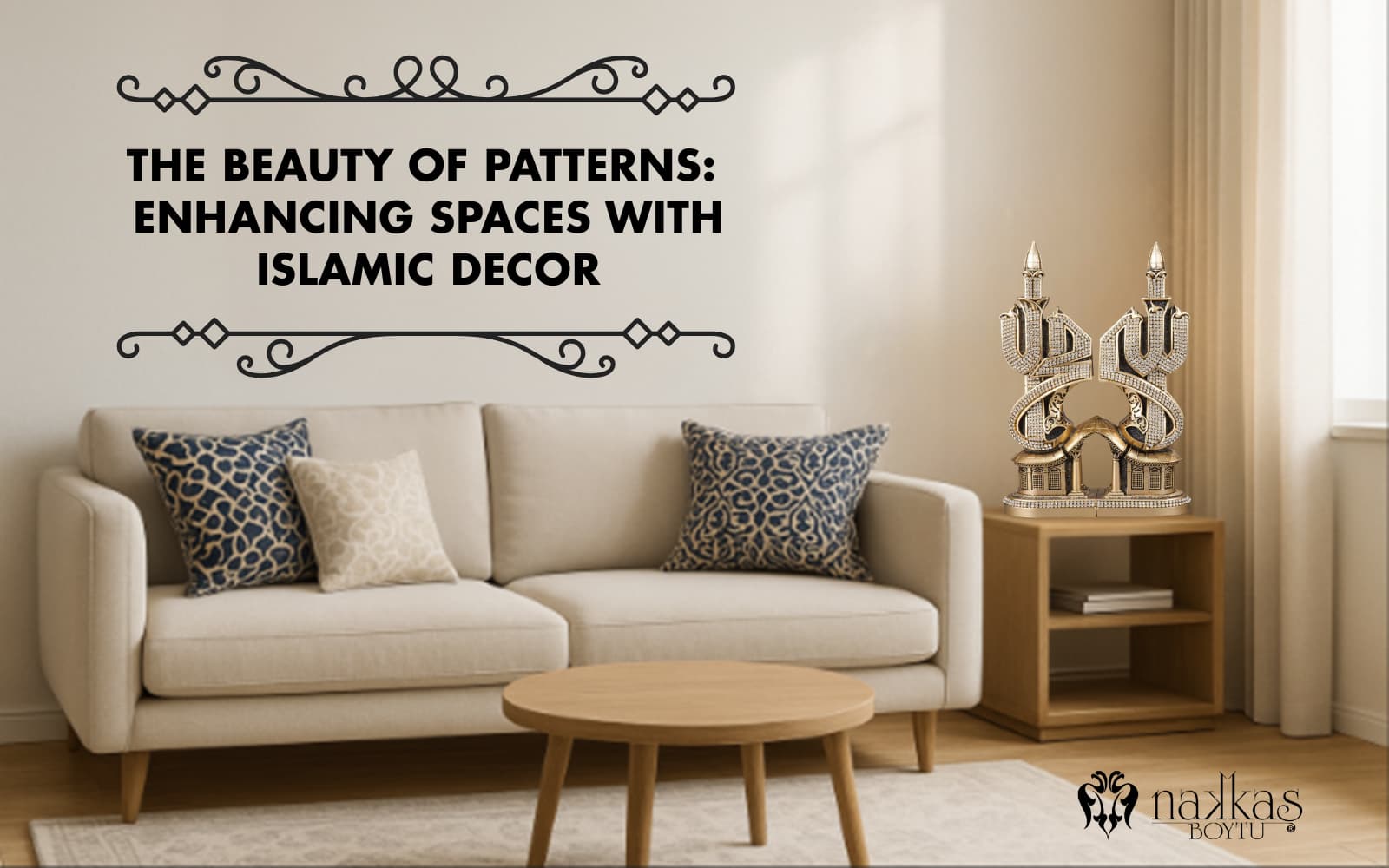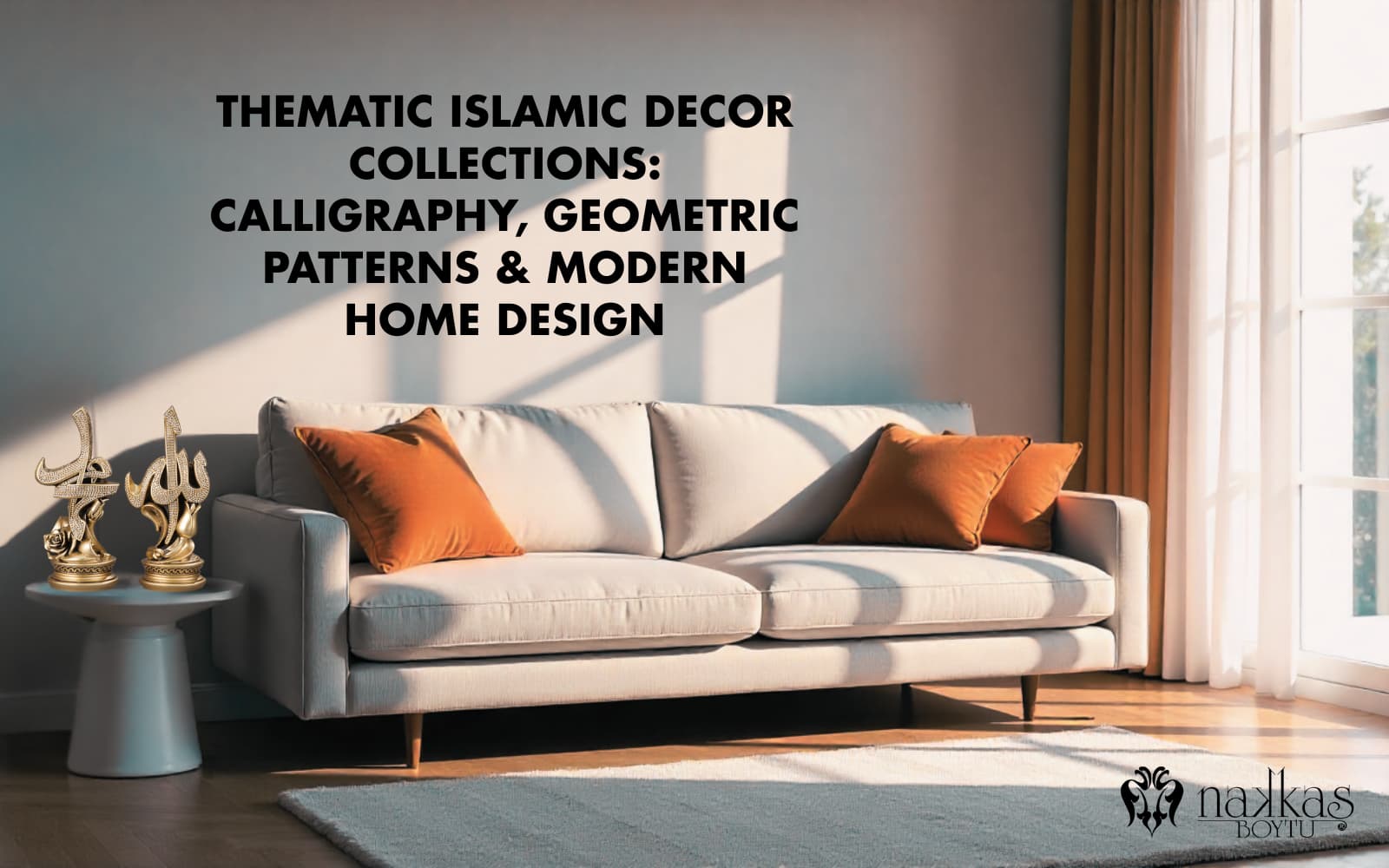While some patterns appeal only to the eye, others carry the accumulated knowledge and beliefs of centuries. Islamic decor is not just a style, but a perspective, a philosophy of life. As UNESCO emphasizes, Islamic art is one of the rare traditions that combine geometric harmony and spiritual meanings.
This aesthetic understanding is a way to design, enrich and even transform traces of the past in modern living spaces. From classical elements to modern adaptations, from symbolic meanings to personalized artworks, this article explores a rich content and shows step by step how Islamic art can play an inspiring role in your home.

What Are the Key Traditional Elements in Islamic Decor?
Islamic decor is rooted in centuries of artistic and spiritual traditions, shaped by religious beliefs, regional aesthetics and architectural innovation. These timeless elements continue to influence classic and contemporary interior design. Here are the key traditional elements of Islamic decor:
- Calligraphy
- Geometric Patterns
- Arabesque Designs
- Floral and Vegetal Motifs
- Mosaic and Tile Work
- Rugs and Carpets
- Symmetry and Rhythm
- Domes and Arches

1. Calligraphy
Calligraphy is a central element in Islamic decor for home, blending spiritual depth with visual elegance. Rooted in sacred traditions, Arabic calligraphy decorates walls, domes and everyday objects with verses from the Quran or poetic texts. Its rhythmic flow and harmonious forms create a spiritual atmosphere, transforming interiors into spaces for reflection.
2. Geometric Patterns
Geometric patterns in Islamic art are built on the principles of unity, symmetry and repetition. They symbolize the divine order underlying all creation. These complex designs of stars, polygons and intertwining lines evoke the concept of unity in multiplicity. Widely used on tiles, ceilings and architectural details, geometric motifs blend visual harmony with spiritual depth.
3. Arabesque Designs
Arabesque designs are intricate, interwoven patterns inspired by stylized plant forms, reflecting the Islamic view of nature as a symbol of eternity. Each line creates a visual feast that balances logic with elegance in rhythmic harmony. Combined with geometric patterns, arabesques adorn walls, ceilings and textiles. Their presence brings a sense of infinite beauty, rooted in artistic depth and spiritual symbolism.
4. Floral and Vegetal Motifs
Islamic decoration uses floral and plant motifs in a stylized way to reflect nature without realistic details. Leaves, vines and flowers are arranged in flowing and balanced patterns that add elegance to surfaces such as walls and textiles. These motifs often serve as visual metaphors rather than direct imitations of nature. Their use enriches surfaces with elegance while preserving the sacred essence of Islamic art.
5. Mosaic and Tile Work
Mosaic and tile work are among the most striking features of Islamic interiors, combining bold colors with intricate patterns. These designs are not only decorative but also carry symbolic meanings based on unity and spirituality. From the walls of the Alhambra to contemporary homes, tiles bring rhythm and harmony to space. They are used in repeating forms and create a sense of continuity and depth.
6. Rugs and Carpets
In Islamic interiors, rugs and carpets are seen as both decorative pieces and expressions of cultural identity. Persian, Turkish and Moroccan rugs feature elaborate geometric and floral motifs that reflect harmony and balance. Beyond their visual appeal, they also create a warm and spiritual atmosphere in homes. These woven works of art combine tradition and comfort in everyday spaces.
7. Symmetry and Rhythm
Islamic decorations for home focus on symmetry and rhythm to create a peaceful and balanced atmosphere. Repeating patterns and mirrored designs bring a sense of order and harmony to the space. This visual structure helps transform everyday interiors into calm environments. It reflects the deeper values of balance found in Islamic art.
8. Domes and Arches
In Islamic design, domes and arches carry deep symbolic meanings beyond their structural elements. Domes often represent the sky or heaven, creating a sense of spiritual space. Arches are seen as gateways to sacred or reflective spaces. These shapes are also used as decorative motifs, adding depth and harmony to the overall design.
Why Is It Important to Blend Traditional and Modern Islamic Decor?
Blending traditional and modern Islamic decor preserves cultural identity while adapting to contemporary lifestyles. Traditional Islamic elements, such as geometric patterns, calligraphy, arabesques, and natural materials, carry deep spiritual and aesthetic meanings. However, as living spaces and design needs evolve, these elements need to be reinterpreted to remain relevant and functional in today's interiors.
Combining modern materials, such as glass, metal, or concrete, with timeless Islamic motifs allows designers to create spaces that are rooted in heritage and in line with current design trends. This balance ensures that it does not become a static tradition, but continues to inspire generations. Ultimately, this harmony between old and new enriches the living experience.
How Can You Integrate Traditional Islamic Decor in Contemporary Spaces?
To integrate traditional Islamic decor into contemporary spaces by blending classic design elements with modern materials and layouts, start by using geometric patterns and arabesques in subtle ways (featured walls, tiles or textiles) to add cultural depth without overwhelming the space. Arabic calligraphy can be added as wall art or decorative objects, offering visual elegance and spiritual meaning.
Where Can You Find Authentic and Meaningful Islamic Decorative Pieces?
You can find authentic and meaningful Islamic decorative pieces at Nakkaş Boytu, which brings the spirit of Islamic art into your home with care and craftsmanship. Their collection includes beautifully designed Islamic table decor items that reflect the elegance of tradition while embracing modern aesthetics. Browse Nakkaş Boytu's products to create a spiritual corner or add a subtle artistic touch to your space.
How Do Handcrafted Islamic Decor Items Preserve Cultural Heritage?
Handcrafted Islamic decor preserves cultural heritage by carrying forward centuries-old design principles rooted in spiritual and artistic traditions. Each piece embodies the values of unity, symmetry and abstraction that define Islamic art. These handcrafted elements showcase the skill of artisans and bring the timeless aesthetics of Islamic culture into today's living spaces. With its intricate patterns and meaningful symbolism, Islamic handcrafted decor continues to celebrate and sustain a rich artistic heritage.
Why Are Personalized Islamic Art Pieces a Unique Way to Connect with Tradition?
Personalized Islamic artwork offers a way to connect with tradition by blending artistic principles with individual meaning. These pieces allow individuals to reflect their personal beliefs and cultural roots in their living spaces. Based on centuries-old design philosophies such as unity, symmetry and abstraction, personalized pieces preserve spiritual values while adapting to modern aesthetics. This fusion of old and new makes them extremely meaningful. Thanks to special Islamic designs, these pieces create a lasting and intimate connection with heritage.
What Impact Does Islamic Decorative Art Have on Home Ambiance?
Islamic decorative art transforms the ambience of the home by creating visually harmonious and spiritually uplifting spaces. Geometric precision, flowing arabesques and calligraphic elements bring a sense of calm, balance and cultural richness to interiors. The use of natural materials and symmetry strengthens the connection between space and spirit, transforming ordinary rooms into serene retreats. Read “How to Beautify a Living Room with Islamic Decorating Ideas?” to see practical ways to achieve this and discover how you can bring this elegance into your home.
How Do Symbolic Elements in Islamic Decor Carry Deep Spiritual Meanings?
Symbolic elements in Islamic decor reflect core spiritual beliefs by translating abstract religious principles into visual form. Motifs such as domes symbolize the heavens, while repeating patterns and symmetry express unity, eternity and divine order. Each design becomes a contemplative space in its own right. This timeless aesthetic is built around Islamic symbols that continue to inspire generations.
Conclusion
Traditional Islamic design isn’t a relic—it’s a living art form that infuses modern spaces with depth and meaning. By weaving calligraphy, geometric motifs, and handcrafted pieces into your décor, you honor centuries-old culture while expressing your unique style today.
Ready to blend heritage and style? Explore our curated Islamic decor collection.









